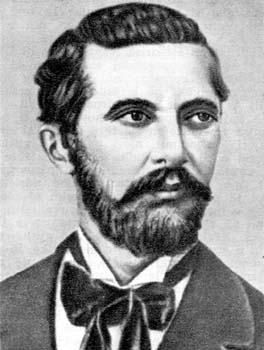
(Naim Frashëri, 1846-1900)
Naim Frashëri is considered one of the most important representatives of national revival literature in Albania (Rilindja kombëtare). He was born in the village of Frashër where he studied Arabic, Persian and Turkish language from the rural mullah and Bektas. In his native town he lived for almost two decades. After his father's death, in 1865, the family moved to the Greek city of Ioannina, in which he and his brother, Sami, went to the Greek gymnasium Zosimaia. Due to the school attending, he enriched his knowledge of language by learning Ancient Greek, Latin and French. After graduation, he briefly worked as a clerk in Istanbul, but, since he was suffering from tuberculosis, he decided to return to his native Frashër whose climate was suitable for this illness. Initially he worked as a civil servant in various cities of Albania, but he eventually returned to Ioannina. From 1881 he lived again in Istanbul and worked as a censor in the Turkish Ministry of Education. During his life he had never returned to his native Albania. In 1884 he received the license for the journal "Light" (Drita), in which he was publishing his poetry in Albanian. He helped create the cultural and patriotic societies in Romania, Egypt and Albania. He died in Istanbul in 1900, and his remains rest in Tirana.
During his life, Naim was exposed to spiritual influence of the eastern as well as of the western philosophy. He was writing in several languages - Albanian, Turkish, Greek and Persian. His early poetry was created under the Persian influence. He wrote twenty two independent works - one in Persian, two in Greek, four in Turkish and fifteen in Albanian language. He wrote poetry (epic and lyric) as well as prose. His creativity can be classified as patriotic, personal and philosophical. The most important Naim’s works are: "Herds and Crops" (Bagëti e buqësia), "Flowers of the Summer" (Lulet e verës), "Paradise and the Flying Word" (Parajsa dhe fjala fluturake), "History of Skanderbeg" (Istori e Skëderbeut).
The poem "Herds and Crops", written in 1886, represents Naim's masterpiece in which he refers a hymn to nature, love and pride for the motherland. In the collection of poems "Flowers of the Summer" from 1890, he describes natural beauty and country life of his homeland. It is considered to be Naim’s best work of poetry. In "Paradise and the Flying Word" he glorifies Alexander the Great, Pyrrhus of Epirus, Skanderbeg and other heroes that the author related with the Albanian national history. And last but not least, his work "History of Skanderbeg", published in 1898, consists of 22 songs and 12,000 verses. Naim here sang an epic about the biggest national hero and his long defense of Christian Albania from Islam.
Naim's political goal was to unite all the Albanians - Gheg and Tosk, Muslims and Christians - and to gain the independence of Albania. He wanted to achieve this through a common and very important thing - through the mother language. Making an effort to raise awareness of the Albanian people about the importance of expressing their ethnicity through language, he wrote poems dedicated to Albanian and its beauty known as "Albanian language" (Gjuha shqipe). He, also, believed that different religions should not prevent the Albanians to unite. He recognized learning of Bektas and referred to it, as he was surrounded by Muslim and Christian friends. One can find information that Naim allegedly wanted to propagate the bektashism as a national religion, because it was inspired by the teachings both in the Bible and the Koran.
Naim and his brother Sami had a significant role in the opening of the first school in the Albanian language (Mësonjëtorja e Pare Shqipe). The school was in Korçë, opened on the 7th of March 1887 and on this occasion it is celebrated every year Teachers' Day throughout Albania. This feast gives thanks to all the teachers, professors and educators who through their work give an example and influence on the development and growth of new generations of students.
Prepared by: Marta Blanuša

